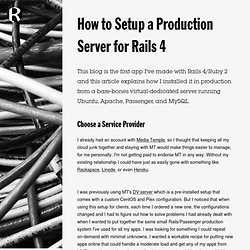

How to Deploy a Rails 4 App With Git and Capistrano // Rob McLarty. I think the two key aspects of any deployment process are speed and consistency.

Speed means you can iterate and fix bugs fast and keep your production code in sync with your development code. Consistency means you know it's going to do the same thing every time so you're not afraid to actually do it and stay up to date. Using a revision control system like Git along with automated deployment recipes with Capistrano satisfies these criteria easily and gives your Rails app a little more oomph. This article assumes you're using a setup like I outlined in my article on how to setup a production server. That is, a Unix server with SSH access using Phusion Passenger and Apache serving a Ruby on Rails app. How to Setup a Production Server for Rails 4 // Rob McLarty. Choose a Service Provider I already had an account with Media Temple, so I thought that keeping all my cloud junk together and staying with MT would make things easier to manage, for me personally.

I'm not getting paid to endorse MT in any way. Without my existing relationship I could have just as easily gone with something like Rackspace, Linode, or even Heroku. I was previously using MT's DV server which is a pre-installed setup that comes with a custom CentOS and Plex configuration. Ruby Trick Shots: A Video of 24 Ruby Tips and Tricks.